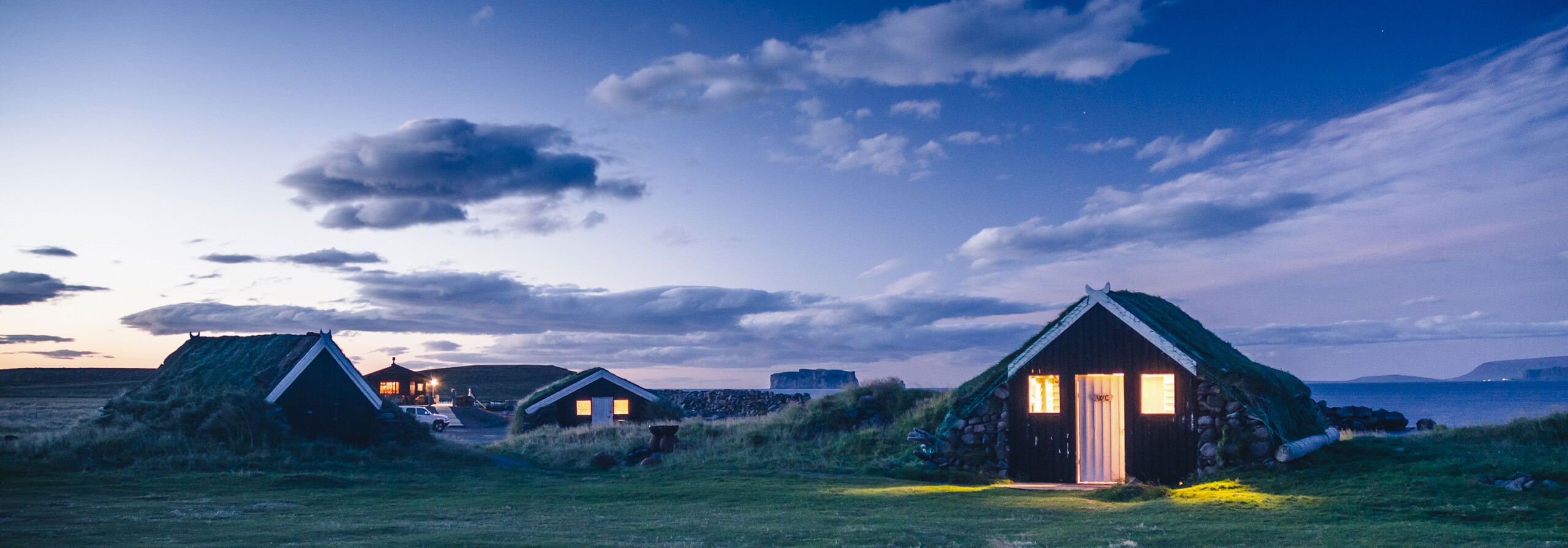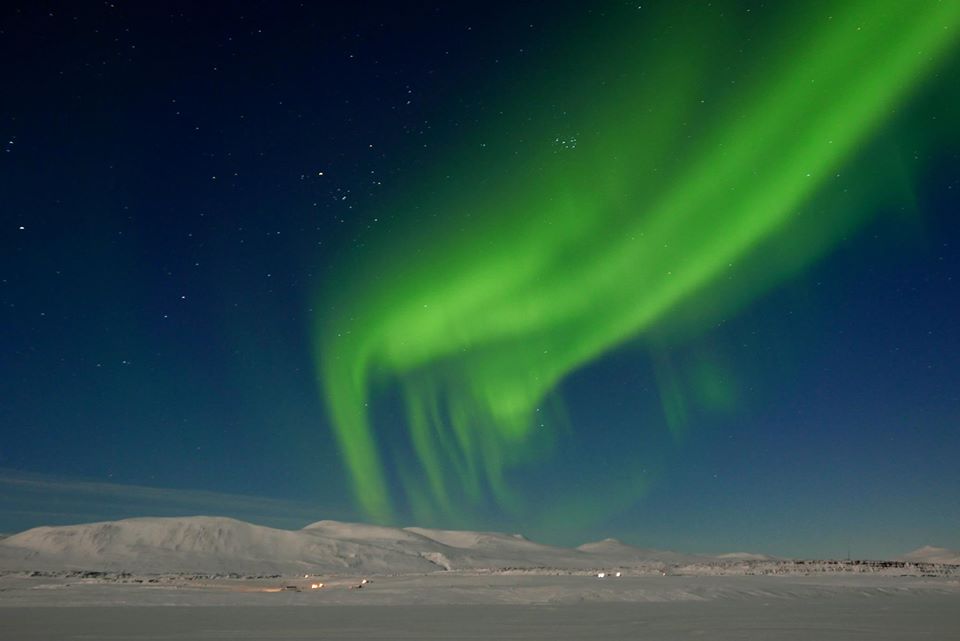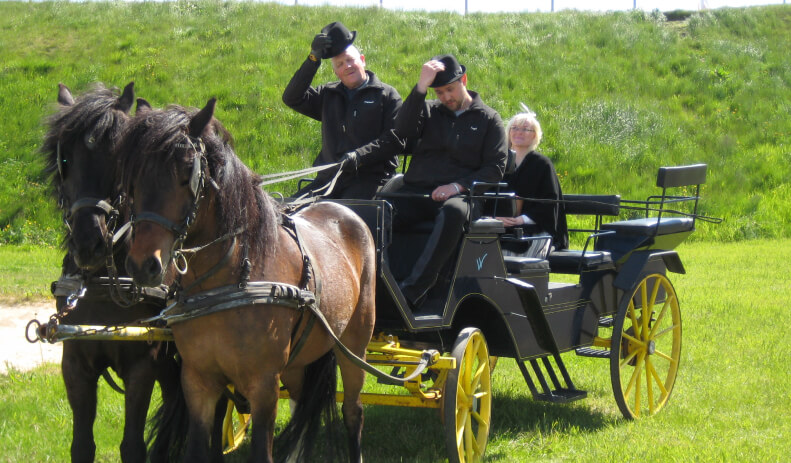Welcome to Skagafjörður
In Skagafjörður it is possible to enjoy both the rich cultural life and lifestyle. The district is an ideal place to enjoy Icelandic nature, horsemanship as well as activities and events for the whole family. Historical sites are many, including museums and exhibits. On this website you can find what Skagafjörður has to offer and you are welcome to contact or visit the Information centre in Varmahlíð or Sauðárkrókur that will assist you to plan a great holiday in Skagafjörður.




Tourist Information Centers in Skagafjörður
Tourist Information Center in Varmahlíð and Sauðárkrókur
The Tourist Information Centers in Varmahlíð and Sauðárkrókur are open all year around. There you can obtain local handcraft, maps and brochures on places of interest in the region.
- Skagafjörður's outdoor activities, entertainment, accomodation, and eating establishments
- Free access to the internet
Tourist Information Center in Varmahlíð
The Tourist Information Center in Varmahlíð is conveniently located right off the ring road, right next to Olis gas station.
- +354 455 6161
- info@visitskagafjordur.is
Tourist Information Center in Sauðárkrókur
The Tourist Information Center in Sauðárkrókur is located at Aðalgata 21, in the same house as Grána Bistró and 1238: The Battle of Iceland at the main street.
- +354 588 1238
- saudarkrokur@visitskagafjordur.is
A Brief History of Skagafjörður
In 1798 the episcopal seat at Hólar was abolished, but in 1881 Skagafjarðarsýsla county purchased the property to establish an agricultural school. Today Hólar University College is a modern, busy university focused on horse breeding, aquaculture and tourism.
The previous history of Skagafjörður was decisively shaped by the presence of the bishop’s seat. On the secular side, however, there were powerful chieftains living at such Skagafjörður estates as Reynistaður, Flugumýri and Ás, to name a few. Guðríður Þorbjarnardóttir settled at the farm at Glaumbær. She had previously voyaged to North America and Rome and was without a doubt the most widely travelled woman of the Viking Age. Although there was a cloister at Reynistaður, that estate was also one of the major bastions of secular power.
Through the centuries, Skagafjörður’s major harbours were Hofsós and Kolkuós, both directly connected with the episcopate. Likewise, the main route east to Eyjafjörður over Hjaltadalsheiði and Heljardalsheiði passed by Hólar.
Known as flashy dressers, the people of Skagafjörður were proud and often preferred to seek other work than farming. In this they were considered rather distinct from other Icelanders. Horsemanship was also widespread in Skagafjörður, with gossipers claiming that many people from Skagafjörður would rather go horseback riding than bother with farm chores. Singing was also given more weight than in many other regions, and culture and literature prospered. Even though the vast majority of Skagafjörður residents made their living through agriculture, many were also engaged in fishing. Stagnation can be said to have marked many fields of Skagafjörður life from about 1650 until 1850, when the impact of the industrial revolution began to be felt, and the Icelandic demand for increased independence from Denmark received a great deal of local support. Trade practices likewise began to change and the general population began to migrate from the countryside. Many moved to North America, but others simply into villages and Iceland”s larger towns.

Sauðárkrókur was legally established as a market town in 1858, and travelling merchants began to trade on the nearby seashore. In 1871 the first resident, the blacksmith Árni Árnason, settled there and began to operate a public house. Two years later the first permanent store was built, founded by Hallur Ásgrímsson, “the Greenland voyager”. In 1875 he sold the store to the merchant Ludvig Popp, who operated it for decades under the name of Popp’s Store (Poppsverslun). Ludvig Popp may be called the father of Sauðárkrókur. He was in charge of or involved in numerous developments in the young community, organising the town to suit its rapid expansion. Around 1900 there were so many stores in the town that some wits called it Kaupmannahöfn (Copenhagen), in reference to the large number of merchants, or kaupmenn. By then the population had multiplied past 400. In 1906 the first motor boat arrived in Sauðárkrókur and by 1916 a pier had been constructed. Shortly before the Second World War a harbour wall was completed. Little by little, a fishing industry was growing, although trading and services for the countryside continued as the main field of employment. In 1940 Sauðárkrókur had 964 inhabitants and in 1970 they numbered 1596. Today Sauðárkrókur has 2620 residents.
Skagafjörður municipality, the larger one in the region of Skagafjörður, is currently home to 4181 residents, with an additional 230 living in the independent Akrahreppur district. Overall, populations have fallen over the past decade. Today fishing, industry, commerce, and public services are the biggest fields of employment at Sauðárkrókur, whereas agriculture remains by far the largest economic sector in other parts of the region.
Theatre has strong roots in Skagafjörður, and entertainment found a common denominator through the years in the form of regional get-togethers, sometimes called Sæluvika or Happy Week. These get-togethers can probably be traced back to 1874 and have included dramatic performances, dances, debates and all sorts of culture, long held in conjunction with an annual meeting of the Skagafjörður county committee members. The festival of Sæluvika is still celebrated today, as a holiday when Skagafjörður residents flaunt their most notable cultural offerings.
Numerous nationally renowned artists have been connected with Skagafjörður. In former times these included the poet Hallgrímur Pétursson and the sculptor Bertel Thorvaldsen, and in more recent times the painters Jón Stefánsson, Sigurður and Hrólfur Sigurðsson, Jóhannes Geir Jónsson and Elías B. Halldórsson; the writers Hannes Pétursson, Guðrún Árnadóttir from Lundi and Gyrðir Elíasson; and the composers Pétur Sigurðsson and Eyþór Stefánsson, to name just a few.
Author:
Unnar Ingvason, director
Skagafjörður Centre for Scholarship
Town and Country
Sauðárkrókur, with a population of around 2600, provides a diversity of services, accommodation, restaurants, shopping, exhibitions, museums, camping facility, night spots, swimming pool, health centre and workshops to name a few. The new sports arena in the middle of the town, south of the swimming pool also doubles as a full sized football field. The exhibition centre at Aðalgata hosts an exhibit of the old workshops from times gone by.
The hills above the town were previously the foreshore of the fjord. Above the town near the cemetery is a viewing platform that provides wonderful views of the old town, the countryside and out to the fjord. There you will also find allotments used by the towns’ people for their sheep, if you are here during spring time you can see the young lambs and foals. The golf course (9 holes) is considered one of the best in Iceland. The name of the town draws its name from the river Sauðá (Sheep river) krókur (hook) i.e. Sheepriverhook. In the valley of Sauðá (sheep river) is Litli Skógur (little forest), which has wonderful little walkways through birch and beech trees and is a lovely place to have a picnic.
The store Verslun Haraldur Júlíussonar is on Aðalgata (Main Street) and has been in business since 1919. When you enter the store you feel as if you are entering another era… the longs lost time of the general store.
To the east of Sauðárkrókur are the town sands (Borgarsandur), a four kilometre long stretch of beach where you can spend your time building sand castles, take long walks and play with the children. A little further south, near Áshildarholtsvatn, at the right time of year, you will find an abundance of divergent birdlife. The area has signage to inform of the species and varieties to be found there. From Sauðárkrókur it takes about half an hour to get to Varmahlíð, Hólar in Hjaltadalur, Hofsós or Grettislaug, and for winter guests the ski area at Tindastóll is only 15 minutes away.
This community offers a wide variety of services for visitors and local people alike, making it one of the most popular stopping points for those travelling along highway 1. There you will find, for example, a service shop with petrol pumps, a food store and restaurant facilities.
The Tourist Information Centre, located right next to the KS shopping premises, has on display, items from the Skagafjörður area, crafted by the Creative Arts Society, Alþýðulist. There is also a good sports stadium, a child-friendly swimming pool and a football practice pitch. If you require a place to stay, there is a wide choice on offer in Varmahlíð and the surrounding area; a hotel, summer chalets, farm accommodation and camping sites.
The Miðgarður Cultural Centre is situated in Varmahlíð and is the locale for a variety of entertainments all year round. The woodland at Reykjarhóll is also recommended, with its marked paths, one of which leads up to the viewfinder at the top of the hill. On a good day, the view across the central region of Skagafjörður is magnificent.
This is one of Iceland’s most famous historical sites and was, for centuries, an Episcopal see. There has been a church at Hólar from the 11th century, the present one dating from 1763. It was built from red sandstone quarried from the mountain Hólabyrða, and is the oldest stone church in Iceland.
The student population at Hólar University College has risen dramatically over the past few years and the number of halls of residence has also increased to meet the demand. During the winter months, over 200 people reside at Hólar.
Archaeological digs have taken place over the past few years and more than 40,000 items have been found. A selection of these finds can be seen in the old schoolhouse. A walk through the winding paths of the wooded area will lead you into the wonderland of natural beauty surrounding this ancient place; a site filled with echoes from Iceland’s history.
During Hólar Festival, which is generally held in the middle of August, there are many ecclesiastical and cultural events on offer, e.g. Pilgrims´ Walks, church services and other activities.
The Laufskálaréttir horse round-up pens at Hjaltadalur are among the most popular in the country, and each year up to 3,000 visitors congregate there to be part of the proceedings. In fact some say that the Laufskálaréttir pens are the crème de la crème of all round-up stations.
Hofsós is a peaceful seaside village on the Eastern shore of Skagafjörður Fjord, with over 400 years of history.
The Hofsós Swimming Pool is fast becoming one of the best known pools in Iceland as well as the most popular tourist attraction in Skagafjörður. The pool is one of the most scenic eternity-pools in Iceland overlooking the island of Drangey and the fjord. Located on the coast just below the swimming pool are the amazing basalt formations at Staðarbjargavík. It is said to have been the capital of the Skagafjörður elf population.
In Hofsós you will find the The Emigration Center, an exhibition about the mass migration of Icelanders to North America in the late 18th century, and few minutes from Hofsós you can step into the past and visit the old times at The Vintage Auto Museum.
Services in Hofsós include accommodation options, cosy restaurants, a grocery store, a fuel station, swimming pool and a campground.
Steinsstaðir has a diverse tourism service where nature can enjoy itself. There are many fun data routes in Steinsstaðir, a selection of accommodation options as well as a millennial forest that is ideal for hiking. You can go rafting and kayaking as well as there are good campsites in the area that are ideal for family gatherings.